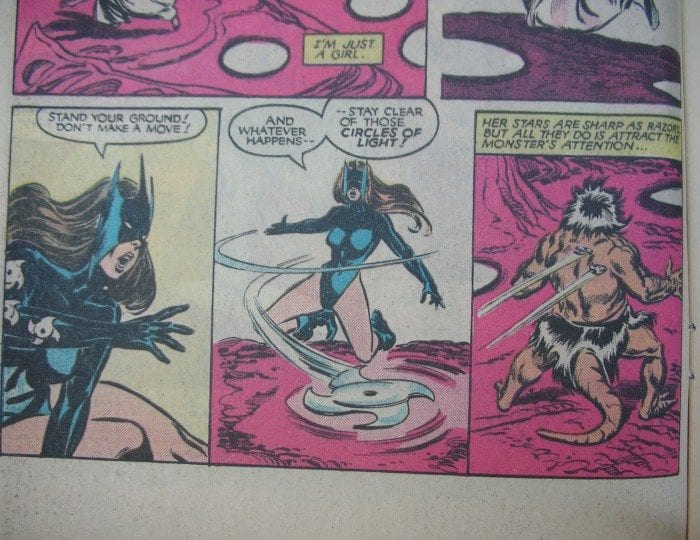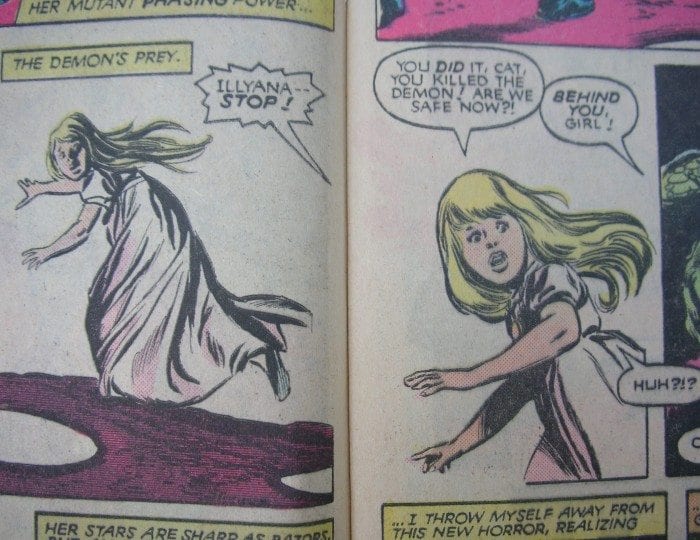This week I thought we could look at a two-page spread from a comic book drawn by John Buscema. The comic is Magik #2 from 1984. It was written by Chris Claremont, drawn by John Buscema with inks by Tom Palmer. Here's the cover:

-------------------------------------
Here's page one. The splash page. It sets up the following two-page spread that I will attempt to dissect. The character Illyana Rasputin is six years old. There she is on the upper right part of the page. The other female character on the page is Kitty Pryde - or some alternate world version of Kitty Pryde. Kitty is protecting Illyana from a demon. That's basically all we need to know to follow the action in order to dissect the following two page spread.

------------------------------------
Here is the two-page spread (below). The demon knocks Kitty to the ground. Then the demon chases Illyana. Kitty recovers and distracts the demon so that Illyana can escape. But then Illyana falls into Kitty's "circles of light" and goes down the rabbit hole.

------------------------------
The "correct" way to read this two-page spread, of course, follows the traditional left-to-right zigzag down the left-hand side of the spread and up to the right and back down. Like this:
------------------------------------
These two pages are interesting to me because, I think, they can be understood visually by reading them "incorrectly"--by beginning in the top left and then going across the center dividing line of the center. Follow the blue lines:
-----------------------------------
Look at the spread again and try reading it visually. Read it across the spread. Follow the blue line path from the above diagram:
------------------------------------
It is my opinion that, visually, the spread can be read both ways. Personally, I think that it still makes sense even if you read the text blocks and the word balloons "incorrectly." But try and just look at the sequencing of the images. John Buscema is able to make the spread read in one sweeping motion. I think this is a remarkable example of thinking about how the two pages will "hang together" in the eye of the reader.
-----------------------------------
Lets take each "tier" at a time. The following is the traditional or correct reading, tier by tier. Page one, tier one:
---------------------------------------
Page one, tier two:
------------------------------------
Page one, tier three:
----------------------------------------
Page two, tier one:
--------------------------------------
Page two, tier two:
--------------------------------------------
Page two, tier three:
-----------------------------------------
Here's the full spread again:
-----------------------------------------
Here is the order of the "incorrect" or "across the spread" reading. This is page one, tier one:
--------------------------------------
If we go across the spread then we read page two's tier one:
---------------------------------------
Then page one's tier two:
-----------------------------------------------
Then page two's tier two:
-------------------------------------------
Back across the spread to page one's tier three:
----------------------------------
Then finally page two's tier three:
-----------------------------------------
Here's the full spread again. Buscema does an excellent job of maintaining a particular scale for the figures that encourages the across the spread reading. Look at how the figures on the top tier of both pages is similar. Kitty is basically drawn at the same scale, particularly in the panels that border the center. And the demon is drawn more or less the same scale in the top tier on both pages as well.
----------------------------------------
The reading pathways again:
-------------------------------------
What I find most fascinating is the center of the spread. The scale of the figures, like I said, encourages an across the spread reading. But there is also the use of the borderless panels with no background color. This, I think, also pushes me across the spread.
------------------------------------
Buscema does a very subtle yet deliberate "hold" and "zoom in" on Illyana that also anchors the entire spread. I think this zoom is the main progression that makes an across the spread reading work. The progression of the dialogue is, of course, fractured or incorrect yet visually it makes sense. It's beautiful.
--------------------------------
Here's the full spread one last time:
-----
I wrote about reading pathways previously on this site. Please check it out here.
----
Over and out. Thanks.
























